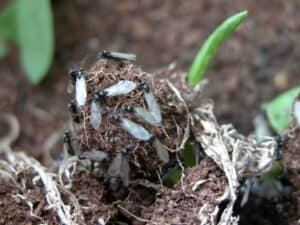Ant Mating Season and Making an Ant Queen
In spring and fall, some of the reproductive caste (winged male ants and virgin queen ants) take off on a nuptial flight at which time they mate. The males soon die and the fertilized females lose their wings and start a new colony. However, very few queens are successful at starting their own colonies and very few are actually able to mate.

During the reproductive season, ant colonies send forth swarms of virgin queens and males that fly or crawl away in search of mates from other colonies. Most are seized by predators, fall in water, or lose their way and die. If a young queen gets lucky during her nuptial flight, she breaks off her dry, membranous wings and searches for a place to build her nest. Even if the new queen finds the right area for her nest, a predator may find her before the excavation can begin.

In the eastern United States, a perfect example of reproductive hopefuls and failures can be seen at the end of each summer. If the ambiance is perfect from a recent rain, and the air is still and warm and humid, around five o’clock, the “Labor Day ant??? can be seen in swarms with males and virgin queens participating in their nuptial flight. For an hour or two the sky is filled with these winged ants. Many unfortunately end up splattered on windshields, eaten by birds and other predators, some stray over waterways and lakes and drown. As the day becomes night and the orgy ends, the last of the survivors flutter to the ground. The fertilized queens then scrape off their wings and search for a place to dig their nest.

Many ant species reproduce this way. Colonies create a large number of queens, like so many seeds, on the chance that at least one or two will take root and be able to build a nest — a new colony.
After leading a life of luxury with workers catering to and feeding the young virgin queen, if she is lucky to mate and finds the right place to build her nest, she soon gets to work by raising her first brood of workers on her own. But then the roles reverse and the queen becomes catered to again and the new workers begin to take care of her, reducing her to nothing more than an egg-laying machine. The queen doesn’t know how to forage for food; she completely relies on her worker daughters for survival.
Queens of most ant species produce a few hundred workers (daughters), plus a dozen or so reproductive queens and males. In the extreme, queens of leafcutter ants in South and Central America each give birth to as many as 150 million workers, with 2 to 3 million alive at any given time (that’s a lot of ants!). African driver-ant queens (also known as Army or Safari ants) may very well hold the record with a colony twice that number – a mass of daughter workers exceeding the human population of the United States!
Got ants? Call today at 1-800-986-1006 for help with an ant infestation. You’re also welcome to complete our contact form and a caring Hearts Pest Management representative will contact you shortly.


